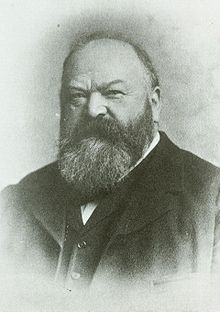Andrew Ainslie Common
Andrew Ainslie Common (born August 7, 1841 in Newcastle upon Tyne , † June 2, 1903 in Ealing ) was a British astronomer .
He was the son of Thomas Common, a doctor. After his father died early, Common joined his uncle's firm in London and married in 1867.
From 1895 to 1896, Common was President of the Royal Astronomical Society .
Scientific contributions
Astrophotography
He made various astrophotographic experiments with his different telescopes. With his 36 ″ reflecting telescope , he took a spectacular picture of the Orion Nebula on January 31, 1883 , for which he received the gold medal of the Royal Astronomical Society in 1884 . During his observations he also discovered numerous nebulae, which he published in the journal Copernicus . These discoveries were later included in the New General Catalog published in 1888 by Johan Ludvig Emil Dreyer . He is considered the discoverer of 29 NGC objects.
Commons 60 inch reflector
In 1885 Common began the construction of a 60-inch (152 cm) aperture - reflecting telescope in Newton arrangement . For this he bought a glass blank, which he cut himself and polished into a parabolic shape. Since the imaging performance of this mirror was inadequate - stars appeared elliptical - he made a second mirror, which he completed in 1890.
Due to a near-fall from the high eyepiece position, Common modified the telescope into a Nasmyth arrangement . However, since he was not entirely satisfied with the result, the light pollution of London reduced astronomical observation possibilities and other projects aroused his interest, he later stopped using the telescope. After Commons death, the telescope with both mirrors was bought from his estate and installed in the Harvard College Observatory . In 1933 the primary mirror was re-ground and fitted with a new holder and installed as a 1.5-meter Boyden-UFS (also known as " 60-inch Rockefeller ") in the Boyden Observatory in South Africa . The second mirror formed the base of the Wyeth telescope at the Oak Ridge Observatory , although it was swapped for a 61-inch mirror made from more modern Pyrex shortly afterwards .
Others
Commonly developed manufacturing techniques for optical plane mirrors.
literature
- Wolfgang Steinicke: Nebulae and Star Clusters. History of their discovery, observation and cataloging - from Herschel to Dreyer's “New General Catalog” Books on Demand, Norderstedt 2009, ISBN 978-3-8370-8350-7 .
Web links
- Andrew Ainslie Common with Wolfgang Steinicke
- Obituary Notices: Fellows: - Common, Andrew Ainslie
- Obituary: Andrew Ainslie Common / Turner, H. H
- List "New Nebulae" in Copernicus (PDF; 390 kB)
- AA Common publications in the Astrophysics Data System
- Obituaries for AA Common in the Astrophysics Data System
Individual evidence
- ↑ "Waywiser, the online database of Harvard's Collection of Historical Scientific Instruments," Object Name: 15875-inch secondary mirror for 60-inch reflecting telescope Inventory Number: 1996-1-0684 Classification: Mirror ( Memento of 15 August 2011 at the Internet Archives )
- ^ Henry King: The History of the Telescope . Dover Publications, Mineola, NY 2003, ISBN 0-486-43265-3 , pp. 295 (English).
| personal data | |
|---|---|
| SURNAME | Common, Andrew Ainslie |
| BRIEF DESCRIPTION | British astronomer |
| DATE OF BIRTH | August 7, 1841 |
| PLACE OF BIRTH | Newcastle upon Tyne |
| DATE OF DEATH | June 2, 1903 |
| Place of death | Ealing |


